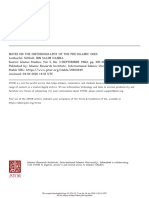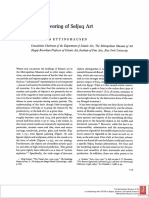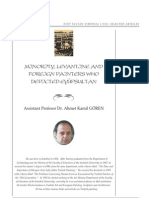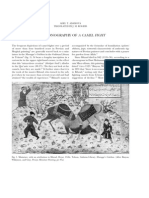0 ratings0% found this document useful (0 votes)
302 viewsBook Felicity Preview
Book Felicity Preview
Uploaded by
Emanuele CiampiThe document describes an illuminated manuscript from 1582 called "The Book of Felicity". It was commissioned by Ottoman Sultan Murad III and contains 71 lavishly illustrated pages with miniatures. The manuscript includes treatises on astrology, oneiromancy, and popular beliefs featuring illustrations of exotic people, places, animals, and monsters. It was created under the guidance of the famous master Osman and his workshop in Constantinople, and presented by the Sultan to his daughter.
Copyright:
Attribution Non-Commercial (BY-NC)
Available Formats
Download as PDF, TXT or read online from Scribd
Book Felicity Preview
Book Felicity Preview
Uploaded by
Emanuele Ciampi0 ratings0% found this document useful (0 votes)
302 views0 pagesThe document describes an illuminated manuscript from 1582 called "The Book of Felicity". It was commissioned by Ottoman Sultan Murad III and contains 71 lavishly illustrated pages with miniatures. The manuscript includes treatises on astrology, oneiromancy, and popular beliefs featuring illustrations of exotic people, places, animals, and monsters. It was created under the guidance of the famous master Osman and his workshop in Constantinople, and presented by the Sultan to his daughter.
Original Description:
Astrology
Copyright
© Attribution Non-Commercial (BY-NC)
Available Formats
PDF, TXT or read online from Scribd
Share this document
Did you find this document useful?
Is this content inappropriate?
The document describes an illuminated manuscript from 1582 called "The Book of Felicity". It was commissioned by Ottoman Sultan Murad III and contains 71 lavishly illustrated pages with miniatures. The manuscript includes treatises on astrology, oneiromancy, and popular beliefs featuring illustrations of exotic people, places, animals, and monsters. It was created under the guidance of the famous master Osman and his workshop in Constantinople, and presented by the Sultan to his daughter.
Copyright:
Attribution Non-Commercial (BY-NC)
Available Formats
Download as PDF, TXT or read online from Scribd
Download as pdf or txt
0 ratings0% found this document useful (0 votes)
302 views0 pagesBook Felicity Preview
Book Felicity Preview
Uploaded by
Emanuele CiampiThe document describes an illuminated manuscript from 1582 called "The Book of Felicity". It was commissioned by Ottoman Sultan Murad III and contains 71 lavishly illustrated pages with miniatures. The manuscript includes treatises on astrology, oneiromancy, and popular beliefs featuring illustrations of exotic people, places, animals, and monsters. It was created under the guidance of the famous master Osman and his workshop in Constantinople, and presented by the Sultan to his daughter.
Copyright:
Attribution Non-Commercial (BY-NC)
Available Formats
Download as PDF, TXT or read online from Scribd
Download as pdf or txt
You are on page 1of 0
TRAVESERA DE GRACIA, 17-21
08021 BARCELONA - SPAIN
TEL. (+34) 932 402 091
FAX (+34) 932 015 062
www.moleiro.com
www.moleiro.com/online
The Book of Felicity
(Matali al-saadet)
The Book of Felicity
(Matali al-saadet)
Bibliothque nationale de France
First, unique and unrepeatable edition, strictly limited to 987 copies
Shelf mark: Suppl. turc 242.
Date: 1582.
Size: 310 x 210 mm.
286 pages and 71 full-page
miniatures lavishly embellished with
gold.
Turkish binding in red leather with
gold decoration.
Full-colour commentary volume.
In the latter half of the 16th century, the Ottoman Empire was the largest
and most powerful in the world. Its domains, stretching from Budapest to
Baghdad, from Oman and Tunis to Mecca and Medina near the Red Sea,
encompassed cities as great as Damascus, Alexandria and Cairo. The Turks
were at the gates of Vienna and controlled the Silk Route, the Black Sea
and the eastern half of the Mediterranean. The sultan governed the empire
from Constantinople, where architects, painters, calligraphers, jewellers,
ceramists, poets, etc, were at his service with his court and harem. The 16th
and early 17th centuries were the most fertile period of Turkish-Ottoman
painting, with the reign of Murad III (1574-1595) being particularly prolific
in beautiful works of art, such as this work by Muhammad ibn Amir Hasan
al-Suudi.
The Book of Felicity was ordered to be translated from the original Arabic
by the sultan himself his portrait appears on folio 8v. It features different
treatises illustrated with splendid illuminations: the Book of Nativities, con-
taining predictions for those born under each of the twelve signs of the
zodiac and a series of splendid miniatures; a short treatise on lunar man-
sions and their influence; a text about the portents based on the parts of
the body affected by spasms; a series of tables for interpreting dreams cor-
rectly; an enigmatic treatise on fortune-telling still applicable today, etc.
The oriental world unfolds before our very eyes in each miniature: myste-
rious characters in peculiar poses, exotic, brightly coloured garments, lux-
urious mansions and sumptuous palaces, muezzins in the minarets of
mosques calling the faithful to prayer, elegant horse-
men riding their stylised horses with lavishly embel-
lished trappings. Some of this fantastic imagery is
inspired directly by traditional tales, such as the
Thousand and One Nights. Also, countless exotic ani-
mals fill the pages of this manuscript: exuberant pea-
cocks, extraordinary sea serpents, giant fish, eagles
and other birds of prey, swallows, storks and other
birds drawn in an elegant, stylised manner. There is
also an entire illustrated chapter on the monsters
appearing in popular belief: the underground world
of the jinns, a population of half-men and half-ani-
mals that are as numerous as the human beings; like
men they can have a good or a bad behaviour, and
will be judged by God at the end of times. They are
not visible to men but they can appear under differ-
ent forms. They were created by God from fire with-
out smoke unlike men and angels who were made
out of clay and light.
All the paintings seem to be by the same workshop
under the guidance of the famous master Ustad
Osman, undoubtedly the artist of the opening series
of paintings dedicated to the signs of the zodiac.
Osman, active between around 1559 and 1596,
directed the artists in the Seraglio workshop from
1570 onwards and created a style, adopted by other
painters at the court, characterised by accurate por-
traits and a magnificent treatment of illustration.
Sultan Murad III was completely absorbed by the
intense political, cultural and sentimental life of the
harem. He had 103 children, only 47 of whom out-
lived him. Nevertheless, Murad III, who held illumi-
nated manuscripts in greater esteem than any other
sultan, commissioned this treatise of felicity especial-
ly for his daughter Fatima.
www.moleiro.com
www.moleiro.com
More information:
Tel. (+34) 932 402 091 - Fax (+34) 932 015 062
www.moleiro.com/online
F. 7v
www.moleiro.com
F. 14v
www.moleiro.com/online
F. 33r
Tel. (+34) 932 402 091
F. 24v
Fax (+34) 932 015 062
F. 79r
UK +44 (0) 20 7193 4986
F. 75v
USA +1 (305) 831 4986
F. 36r
www.moleiro.com
F. 74v
www.moleiro.com/prensa
F. 35r
Tel. (+34) 932 402 091
F. 85v
Fax (+34) 932 015 062
F. 87v
UK +44 (0) 20 7193 4986
F. 88v
USA +1 (305) 831 4986
You might also like
- The Conference of The Birds (Penguin Classics) : Download Free (EPUB, PDFDocument5 pagesThe Conference of The Birds (Penguin Classics) : Download Free (EPUB, PDFsabeeqa100% (1)
- Fatima Daughter of Muhammad (2nd Edition) (Christopher Paul Clohessy) (Z-Library)Document373 pagesFatima Daughter of Muhammad (2nd Edition) (Christopher Paul Clohessy) (Z-Library)Naqui HusainNo ratings yet
- Shah Isma Il S Poetry in The Silsilat Al Nasab I SafawiyyaDocument18 pagesShah Isma Il S Poetry in The Silsilat Al Nasab I SafawiyyaaliNo ratings yet
- Book Felicity Vii 11Document36 pagesBook Felicity Vii 11ancuta100% (2)
- Princeton University Press A History of Jewish-Muslim RelationsDocument10 pagesPrinceton University Press A History of Jewish-Muslim Relationshappycrazy99No ratings yet
- Grube, Ernest J. - Threasure Od Turkey-The Ottoman Empire (The Metropolitan Museum of Art Bulletin, V. 26, No. 5, January, 1968) .Document21 pagesGrube, Ernest J. - Threasure Od Turkey-The Ottoman Empire (The Metropolitan Museum of Art Bulletin, V. 26, No. 5, January, 1968) .BubišarbiNo ratings yet
- The Story of The Boy and The KingDocument3 pagesThe Story of The Boy and The KingchkhannbsNo ratings yet
- A History of Ottoman Political Thought Up To The Early NineteenthDocument608 pagesA History of Ottoman Political Thought Up To The Early NineteenthSebastienGarnierNo ratings yet
- Jameh Mosque of IsfahanDocument5 pagesJameh Mosque of IsfahanRobert HowardNo ratings yet
- Ibn Arabi Selected Poems 416 v55eWrL PDFDocument3 pagesIbn Arabi Selected Poems 416 v55eWrL PDFRoughDiamondNo ratings yet
- The First Shaykh Al-Islām of The Safavid Capital QazvinDocument20 pagesThe First Shaykh Al-Islām of The Safavid Capital QazvinSherlock HolmesNo ratings yet
- GhuslDocument27 pagesGhuslAbdul RehmanNo ratings yet
- Picturing The Archetypal King Iskandar I PDFDocument8 pagesPicturing The Archetypal King Iskandar I PDFaustin100% (1)
- Kenan Rifai BookreviewDocument7 pagesKenan Rifai BookreviewashfaqamarNo ratings yet
- World Heritage Records-Of-Sufism Volume2Document535 pagesWorld Heritage Records-Of-Sufism Volume2Iqbal Ahmed MasanakattiNo ratings yet
- Khoja Ahmad Yasawi QSDocument12 pagesKhoja Ahmad Yasawi QSiie.aid.afdNo ratings yet
- Akm IstanbulDocument393 pagesAkm IstanbulMaksut Maksuti100% (1)
- Ibn Al Fāri, The Poem of The Way, Tr. ArberryDocument87 pagesIbn Al Fāri, The Poem of The Way, Tr. ArberryZoé100% (1)
- Pen-Case and Candlestick: Two Sources For The Development of Persian Inlaid MetalworkDocument15 pagesPen-Case and Candlestick: Two Sources For The Development of Persian Inlaid MetalworkLejla BecarNo ratings yet
- Islamic Copper Based Metalwork From TheDocument5 pagesIslamic Copper Based Metalwork From TheSavas MaraşlıNo ratings yet
- Fatimid and Ayyubid DynastyDocument10 pagesFatimid and Ayyubid Dynastyapi-19753215No ratings yet
- Syedna Taher Saifuddin Saheb MemoriesDocument72 pagesSyedna Taher Saifuddin Saheb MemoriesHarman KraniNo ratings yet
- Erkinov - Persian-Chaghatay BilingualismDocument27 pagesErkinov - Persian-Chaghatay Bilingualismvlad-bNo ratings yet
- Pir Karam Shah On AlaHazratDocument8 pagesPir Karam Shah On AlaHazratShoaib KhanNo ratings yet
- Harmony and Islam - The Harmony ProjectDocument16 pagesHarmony and Islam - The Harmony ProjectElia KwanNo ratings yet
- Hanna - NOTES ON THE HISTORIOGRAPHY OF THE PRE-ISLAMIC ODESDocument10 pagesHanna - NOTES ON THE HISTORIOGRAPHY OF THE PRE-ISLAMIC ODESAtef AlshehriNo ratings yet
- The Muslim Tatar Cultural Legacy in ItsDocument13 pagesThe Muslim Tatar Cultural Legacy in ItsVon Agram JuliusNo ratings yet
- Manuscripts of Ottoman-Safavid RelationsDocument18 pagesManuscripts of Ottoman-Safavid RelationsfauzanrasipNo ratings yet
- How Does One Become An Oriental OrientalDocument13 pagesHow Does One Become An Oriental OrientalNehir TorunoğluNo ratings yet
- The Flowering of Seljuq ArtDocument19 pagesThe Flowering of Seljuq ArtnusretNo ratings yet
- Seyyed Hossein Nasr Islamic Art and Spirituality PDFDocument263 pagesSeyyed Hossein Nasr Islamic Art and Spirituality PDFHamza Junaid100% (1)
- Catalogue of Persian Manuscripts in Brit - Museum - Rieu, 1879 - Vol.2 PDFDocument464 pagesCatalogue of Persian Manuscripts in Brit - Museum - Rieu, 1879 - Vol.2 PDFsi13nz100% (2)
- 09 AhmetDocument15 pages09 AhmetRuy Pardo DonatoNo ratings yet
- Samarqandi Chahar Maqala Revised EditionDocument198 pagesSamarqandi Chahar Maqala Revised EditionbanarisaliNo ratings yet
- 2004 Adamova Iconography of A Camel FightDocument14 pages2004 Adamova Iconography of A Camel FightlamiabaNo ratings yet
- Gifts of The SultanDocument6 pagesGifts of The SultanYumna YuanNo ratings yet
- 14 Ottoman MiniatureDocument36 pages14 Ottoman Miniatureourbook100% (1)
- This Document Contains Text Automatically Extracted From A PDF or Image File. Formatting May Have Been Lost and Not All Text May Have Been RecognizedDocument30 pagesThis Document Contains Text Automatically Extracted From A PDF or Image File. Formatting May Have Been Lost and Not All Text May Have Been RecognizedmfazlullahNo ratings yet
- Some Notes On The Naqshbandī Tarīqat in Bosnīa (Hamid Algar) PDFDocument26 pagesSome Notes On The Naqshbandī Tarīqat in Bosnīa (Hamid Algar) PDFIsraelNo ratings yet
- Vernon O. Egger - A History of The Muslim World To 1405 - The Making of A CivilizationDocument484 pagesVernon O. Egger - A History of The Muslim World To 1405 - The Making of A CivilizationGiulli HelenNo ratings yet
- Early Muslim History Needs Fresh AppraisalDocument29 pagesEarly Muslim History Needs Fresh Appraisalshafique0% (1)
- El-Rouhayeb, K. (2006) - Opening The Gate of VerificationDocument20 pagesEl-Rouhayeb, K. (2006) - Opening The Gate of VerificationYehya Abdul RahmanNo ratings yet
- Samples of Pictures From The Scared TrustsDocument7 pagesSamples of Pictures From The Scared TrustsTariq100% (1)
- Cheikh Ahmed Ben IdrissDocument14 pagesCheikh Ahmed Ben IdrissBawba AbdallahNo ratings yet
- Ra'fatul Bari Vol-IV by Dr. Rafiq AhmadDocument404 pagesRa'fatul Bari Vol-IV by Dr. Rafiq AhmadtakwaniaNo ratings yet
- The Zafarnama of Sultan Husayn Mirza PDFDocument18 pagesThe Zafarnama of Sultan Husayn Mirza PDFJoshua Immanuel GaniNo ratings yet
- Mayer Yogic SufiDocument19 pagesMayer Yogic SufiOscar DVNo ratings yet
- OehDocument15 pagesOehterserahNo ratings yet
- 668 1 PDFDocument89 pages668 1 PDFNoori Al-HanafiNo ratings yet
- Kuchumkulova - Kyrgyz Nomadic Customs and The Impact of Re-Islamization After Independence, 2007Document425 pagesKuchumkulova - Kyrgyz Nomadic Customs and The Impact of Re-Islamization After Independence, 2007Hugo Leonardo RibeiroNo ratings yet
- Al-Bīrūnī's Arabic Version of Patañjali's "Yogasūtra"Document42 pagesAl-Bīrūnī's Arabic Version of Patañjali's "Yogasūtra"Jacob BargerNo ratings yet
- Potter, Lawrence, Sufis and Sultans in Post-Mongol IranDocument27 pagesPotter, Lawrence, Sufis and Sultans in Post-Mongol IranhulegukhanNo ratings yet
- Chahar Maqala NizamiDocument210 pagesChahar Maqala NizamiJabir ZamanNo ratings yet
- Examples of Kufic Maghribi ScriptDocument1 pageExamples of Kufic Maghribi ScriptMohammed Abdul KhaderNo ratings yet
- Secrets of Surah Al KahfDocument4 pagesSecrets of Surah Al KahfMashruba TasnimNo ratings yet
- Frontier Fictions: Shaping the Iranian Nation, 1804-1946From EverandFrontier Fictions: Shaping the Iranian Nation, 1804-1946No ratings yet
- Eclissi Solari Visibili A Wuhan PDFDocument3 pagesEclissi Solari Visibili A Wuhan PDFEmanuele CiampiNo ratings yet
- Robin WilliamsDocument1 pageRobin WilliamsEmanuele CiampiNo ratings yet
- Raphael - Guide To Astrology-Genethliacal Astrology-GANN LIST AUTHORDocument131 pagesRaphael - Guide To Astrology-Genethliacal Astrology-GANN LIST AUTHOREmanuele Ciampi100% (1)
- Ptolemy Stars CatalogueDocument236 pagesPtolemy Stars CatalogueEmanuele Ciampi100% (2)
- Volume of Oriental 00 Arno U of TDocument530 pagesVolume of Oriental 00 Arno U of TEmanuele CiampiNo ratings yet
































































